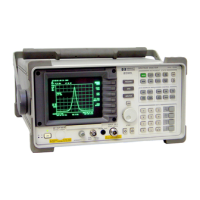ACCEPT
QP DATA
For Option 103 only.
displays the quasi-peak amplitude value of the marker. See the HP 85913,
HP 8593E, HP 85943, HP 85953, or HP 8596E Option 103 supplement
documentation for more information.
Front-Panel Key Access:
[AUXCTRL)
ACPGRAPH
ON OFF
turns the adjacent channel power graph ON or OFF. With ACPGRAPH ON
the ACP ratio graph is calculated and displayed and the numeric results are
not displayed. The value of the ACP ratio is displayed at the selected marker
frequency offset from the center frequency. This graph function is used after
doing an adjacent channel power measurement with the ADJ CHAN POWER or
ADJ CHAN PWR extd softkeys.
Front-Panel Key Access:
[MEAS/USER)
ADJ CHAN
POWER
measures the power leakage into the adjacent channels and calculates the
adjacent channel power ratio of both the upper and lower channels, with
respect to the total power. The total power of the carrier is displayed. The
adjacent channel power ratios of both channels are also displayed and the
larger number is marked with a A. (Vertical lines on the display indicate the
bandwidth edges of the three different channels being measured.)
The measurement can be made on a single sweep or continuously updated at
the end of each sweep. See SINGLE
MEAS
and CONT
MEAS
. The measurement
stops and the spectrum analyzer is returned to its prior state when other
measurement functions are activated.
The center frequency must be set to the intended carrier frequency and the
reference level set to optimize the displayed signal. The channel bandwidth
and channel spacing must be entered by the user. If
PARAM
AUTO is selected
(so AUTO is underlined), other spectrum analyzer settings will then be coupled
and set automatically. The adjacent channel power measurement responds to
signals like an rms power measurement. This means that the measurement of
the total channel power and the adjacent channel power ratios are accurately
reported, whether the transmitted signal contains tones, noise, or both. If
PARAM
AUTO is selected the parameters of the instrument state are set for a
valid measurement. When using
PARAM
MAN, the following conditions must
be maintained to make a valid rms measurement. If these conditions are not
met, errors of up to -2.5
dB
can occur for noise-like signals.
n Video bandwidth is at least 10 times the resolution bandwidth.
w
Detector mode is sample (SMP). (You can use DETECTOR SMP PK to select the
detector mode.)
n Resolution bandwidth is less than or equal to 100
kHz.
n Video averaging is OFF
n Neither MAX HOLD nor MIN HOLD trace mode is selected.
Front-Panel Key Access:
[MEAS/USER)
7-6 Key Descriptions

